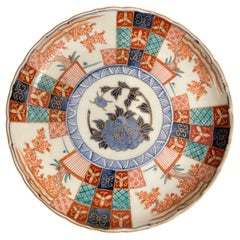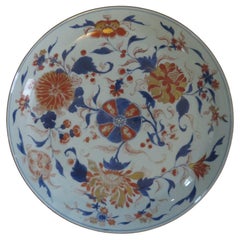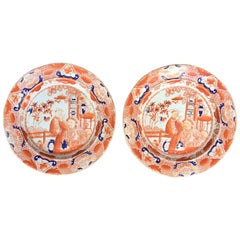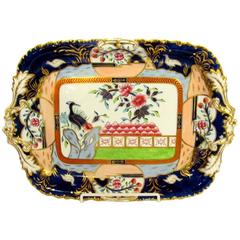Chinese Imari Marks
A Chinese Imari Style Plate with Chenghua Mark, 19th century
Located in ARMADALE, VIC
A Chinese Imari Style Plate with Chenghua Mark, 19th century
Provenance: Private Victoria
Category
Antique 19th Century Chinese Ceramics
Materials
Porcelain
Chinese Kangxi mark & period Very Large Imari Dish or Plate Porcelain, Ca 1710
Located in Lincoln, Lincolnshire
This is a very beautifully hand painted Chinese Imari porcelain very large Dish or Plate / Platter
Category
Antique Late 17th Century Chinese Qing Ceramics
Materials
Porcelain
$1,301
H 2.25 in Dm 14.7 in
Recent Sales
English Ironstone China Imari Style Plates by Masons with Patent Mark circa 1815
Located in Atlanta, GA
impressed Patent Mark. Rare Imari style pattern.
Category
Antique Early 19th Century English Dinner Plates
Materials
Porcelain
Antique English Copeland Spode China Imari Cabaret or Vanity Tray
By W. T. Copeland
Located in CHARLESTON, SC
Extraordinary antique English Copeland Spode China Imari cabaret tray,
with printed mark for W.T
Category
Antique Mid-19th Century English Serving Pieces
Materials
Porcelain
Qing Kangxi Period Chinese Vase Porcelain Fine Detail Garlic neck, Circa 1690
Located in Lincoln, Lincolnshire
underglaze blue which, though often seen out of period , is a Kangxi period mark.
Chinese Imari is quite
Category
Antique Late 17th Century Chinese Qing Ceramics
Materials
Porcelain
Chinese Imari Porcelain Plate or Bowl Qing Kangxi Mark and period, Ca 1700
Located in Lincoln, Lincolnshire
This is a beautifully hand painted Chinese Export porcelain plate or bowl from the Qing, Kangxi
Category
Antique Early 18th Century Chinese Chinese Export Ceramics
Materials
Porcelain
People Also Browsed
18th Century Chinoiserie Lacquered Table Mirror
Located in LA CIOTAT, FR
This unusual table-top 'Psyche' table mirror dates from the 18th century, its wooden frame beautifully crafted from yellow-lacquered wood and decorated with hand-painted chinoiserie ...
Category
Antique 18th Century French Chinoiserie Table Mirrors
Materials
Mirror, Wood
Antique Dutch Marquetry Toilet Mirror
Located in Bradford-on-Avon, Wiltshire
An exceptional Dutch marquetry walnut toilet mirror with flower inlays in bone and woods. Original colour and patina. Attractive shaping to the mirror frame and drawer front. Fitted ...
Category
Antique 1730s Dutch Table Mirrors
Materials
Walnut
Antique Chinese Export Porcelain Dish 18th Century Qianlong Era Circa 1760
Located in Katonah, NY
This antique Chinese export porcelain dish was hand-painted in the mid-18th century in the Qianlong Era.
It features a blossoming plum tree adorned with orange, blue, and gold flower...
Category
Antique Mid-18th Century Chinese Qing Ceramics
Materials
Porcelain
Pair Antique 18C Meissen Porcelain Neuozier Marcolini Period Plates with Flowers
By Meissen Porcelain
Located in Philadelphia, PA
A fine pair of antique Neuozier pattern plates.
By the Royal Meissen Porcelain Manufactory.
Decorated with Deutsche Blumen floral sprays to the center and sides including roses...
Category
Antique Late 18th Century German Rococo Porcelain
Materials
Porcelain
$1,250 / set
H 1.75 in Dm 9.75 in
Matching Pair of Large Single Antique Beds in Cream MP60
Located in Wrexham, GB
A matching pair of cast iron antique beds with ornate arched back panels, finished in cream.
These beds accept 3ft 6in (42 inch or 107 cm) wide bases and mattresses.
The beds can be ...
Category
Antique Late 19th Century English Victorian Beds and Bed Frames
Materials
Steel, Iron
Large antique 19th century quality Chinese porcelain bowl
Located in Ipswich, GB
Large antique 19th century quality Chinese porcelain bowl, having fantastic floral decoration throughout in wonderful red, orange, blue, yellow and gold colours on a white ground.
...
Category
Antique Early 19th Century Ceramics
Materials
Porcelain
Mid Century Rattan Wicker Emmanuelle Peacock Oval Wall Mirror Spain, C.1970
Located in London, GB
Mid Century Rattan Wicker Emmanuelle Peacock Oval Wall Mirror Spain, C.1970
Excellent condition commensurate of age.
Category
Vintage 1970s Spanish Wall Mirrors
Materials
Wicker, Rattan
$2,037
H 25.2 in W 21.26 in D 1.58 in
Antique 18th century Antique Kangxi Yongzheng Chinese Porcelain Imari Plate
Located in Amsterdam, Noord Holland
A Chinese porcelain dish from the first half of the 18th century. Lotus and pommegranate
Condition
Rimfritting and Chips. Size 21cm
Period
18th century
Category
Antique 17th Century Edo Ceramics
Materials
Porcelain
$936 Sale Price
20% Off
H 1.19 in Dm 8.27 in
18th Century Italian Venetian Chinese Style Painted Headboard
Located in Southampton, NY
18th century Italian Venetian Chinese style painted headboard
having a Chinese Pagoda style form and Chinoiserie Design.
Category
Antique 18th Century Italian Regency Beds and Bed Frames
Materials
Wood, Paint
$20,000 Sale Price
20% Off
H 64 in W 64 in D 2 in
Large Japanese Imari Charger, Edo/Meiji Period, mid 19th century, Japan
Located in Austin, TX
A large 18.25" diameter Japanese Imari porcelain charger, Edo to Meiji Period, mid 19th century, Japan.
The large charger of near flattened form and decorated in the typical Imari p...
Category
Antique Mid-19th Century Japanese Meiji Ceramics
Materials
Porcelain
18th Century Chinese Imari Plate
Located in Delft, NL
18th Century Chinese Imari plate
A Kangxi, Imari underglaze blue plate with scene of peonies and gold and red painted , bamboo and deer
1662-1722 Kangxi period
The plate has som...
Category
Antique 18th Century Chinese Antiquities
Materials
Porcelain
Very Fine Gilt Bronze, Cloisonné Enamel and Porcelain Holy Water Stoup
Located in London, GB
A very fine gilt bronze, cloisonné enamel and porcelain holy water stoup
French, late 19th century
Measures: Height 54cm, width 34cm, depth 9cm
This beautiful piece is an ormolu...
Category
Antique Late 19th Century French Renaissance Religious Items
Materials
Enamel, Ormolu
Samuel Alcock Footed Comport, Melted Snow, Periwinkle Lilac, Flowers, ca 1822
By Samuel Alcock & Co.
Located in London, GB
A footed rectangular central comport or centre piece, periwinkle / lilac ground with melted snow and holly leaf borders and flowers, a large pink wild rose painting in the centre
Th...
Category
Antique 1820s English Regency Serving Bowls
Materials
Porcelain
$1,285
H 1 in W 1 in D 1 in
2 Flowery "George Sand" Dessert Plates
By Aude Clément
Located in Paris, FR
Very original set of 2 earthenware dessert plates in the "George Sand" set. It's named this way because inspired by the famous set created by the French manufactory Creil & Montereau...
Category
2010s French Tea Sets
Materials
Earthenware
18th Century Polychrome Delft Oil and Vinegar Stand
Located in Haddonfield, NJ
18th Century polychrome Delft oil and vinegar stand in Imari flower decorations.
Category
Antique Mid-18th Century Dutch Baroque Delft and Faience
Materials
Delft
Perfect Antique Edo period Ca 1680 Japanese Porcelain Plate Arita Kraak Dish
Located in Amsterdam, Noord Holland
Sharing with you this very nice edo period, 1680-1700, example. With a central scene of a flowers. Rare Japanese Kraak interpretation. The rim beautifully painted.
Marked at base.
...
Category
Antique 17th Century Edo Decorative Dishes and Vide-Poche
Materials
Porcelain
$2,378
H 1.03 in Dm 6.97 in
Get Updated with New Arrivals
Save "Chinese Imari Marks", and we’ll notify you when there are new listings in this category.
Chinese Imari Marks For Sale on 1stDibs
There is a range of Chinese imari marks for sale on 1stDibs. Frequently made of ceramic, porcelain and stoneware, all Chinese imari marks available were constructed with great care. Chinese imari marks have been produced for many years, with earlier versions available from the 18th Century and newer variations made as recently as the 20th Century. Chinese imari marks are generally popular furniture pieces, but Regency, Georgian and Victorian styles are often sought at 1stDibs. Chinese imari marks have been a part of the life’s work for many furniture makers, but those produced by Mason's Ironstone, Spode and Coalport Porcelain are consistently popular.
How Much are Chinese Imari Marks?
Chinese imari marks can differ in price owing to various characteristics — the average selling price at 1stDibs is $757, while the lowest priced sells for $90 and the highest can go for as much as $29,500.
Questions About Chinese Imari Marks
- 1stDibs ExpertAugust 20, 2024To identify Chinese porcelain marks, consult trusted online resources. Most markings on Chinese porcelain consist of four to six characters, and the last two often represent when a piece was produced. Since there is a lot of variation in the markings, looking at images shared on trustworthy websites is the best way to make an identification. Alternatively, you can use the services of a certified appraiser or knowledgeable antique dealer. On 1stDibs, explore a wide range of Chinese porcelain.
More Ways To Browse
Spode Chelsea
Imari Copeland Spode
Masons Ironstone Imari Style
Used Western Spurs
Western Spurs
Japanese Wall Pockets
Jian Ware
Kang Hsi
Korean Incense Burners
Kyoto Vase Satsuma
Mashiko Plate
Modern Japanese Studio Pottery Oribe Vase
Peach China Plate
Peranakan Porcelain
Persian Fish Ceramics
Persian Qajar Porcelain
Red Chinese Foo Dogs
Retro Treasure Craft Pottery



